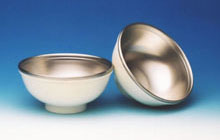TIME TO EAT:
Looking for New Approaches to School Lunches
October 25, 1999

Students are eating their lunches from dishes using environment-friendly materials. (Jiji Press)
For the hard-working students at Japanese schools, the lunch hour is a welcome break from their studies, and one of the favorite times of the school day. But kids have to eat lunch in the same classroom where they study, on the same desks; what is more, the dishes used for school lunches are designed mainly with practicality and cost in mind, making the eating experience somewhat bland. To combat this monotony, schools across Japan are now taking various steps to make lunchtime more enjoyable.
Over 100 Years of Lunches
School lunch programs in Japan have more than a century of history behind them. In 1889 religious organizations began providing lunches for some students at primary schools whose families could not afford to send one with them. But it was not until after the end of World War II that school lunch programs were begun on a nationwide scale. Amid the food shortages of the immediate postwar period, emergency LARA supplies--food and other items from the United States provided by the Licensed Agencies for Relief of Asia--formed the basis for a lunch system that spread to schools across the country. There remain many older Japanese to this day who have fond memories of the school lunches they ate during these difficult times.
As the national food situation improved, lunch programs came to focus more on educational aspects of the lunchtime experience. Students learned about the importance of a balanced diet and proper mealtime manners as they ate. Although generations of students have now learned these lessons in similar ways, lunch menus changed over the years as different ingredients became available. People of different ages now reminisce over different favorite dishes from their school days.
Learning While You Eat
In general, students eat lunch in their classrooms rather than in a cafeteria. A group of students designated as the "lunch squad" goes from each class to get the food, which has been prepared in the school kitchen or at a regional school-lunch center. This group, whose members are rotated regularly, is also in charge of passing out lunches and cleaning up after the lunch period. Homeroom teachers eat together with their students, teaching them table manners and warning them not to be picky in what they eat; this helps make lunchtime an educational part of the day.
In Japanese schools, students remain in one classroom and teachers of various subjects come to them. This means that the kids see the same four walls all day--even at lunchtime. Lately, however, with dropping school populations caused by lower birthrates, many schools have seen classrooms open up. These unused rooms are more and more being put to use as lunch rooms, giving the students a chance to see some different scenery once a day and helping them to relax a bit and enjoy their meals.
Back to Natural Materials
The dishes used for meals are chosen by schools according to how light, tough, and inexpensive they are. These conditions have led many schools to choose aluminum bowls or dishes made of polypropylene or some other synthetic resin. But metal containers get too hot to hold when filled with soup, a fact that has made polycarbonate the most popular choice over the years.
Recently new fears have cropped up concerning these plastic bowls, though, as research points to the possibility that heated dishes could secrete small amounts of chemicals known as endocrine disruptors. Schools across the nation are beginning to look to other options: A May 1999 survey of public elementary and middle schools found that only 32.7% of schools still relied on polycarbonate bowls, down 7.4 points from 1998. Alternatives remain hard to come by, though. Ceramic is one natural option, but these dishes are heavy, easily broken, and expensive. According to another recent survey, only 13% of schools in Japan have gone the ceramic route; glass dishes, meanwhile, have made their way into only 5% of school lunchrooms.
In response to this situation, one manufacturer has launched production of tough stainless steel dishes with a polypropylene layer cushioning the outside. As the dishes use no adhesive to hold the layers together, when the units get old they can be broken down into their separate materials and recycled.
Meanwhile, another designer who criticizes the one-sided focus on practicality is pushing for the use of dishes made of ceramics, lacquer, glass, and wood, urging people to "pay more attention to the eating experience of the children who will use them" Takeo Hasegawa recently opened a display of school lunch dishes entitled "Dishes for Children." He stresses: "Children need to learn about the warmth these materials have; about how pleasant they are to use. Discovering how to treat delicate materials is an important part of school lunch education as well."
 Edited
by Japan Echo Inc. based on domestic Japanese news sources. Articles presented
here are offered for reference purposes and do not necessarily represent
the policy or views of the Japanese Government.
| 


















